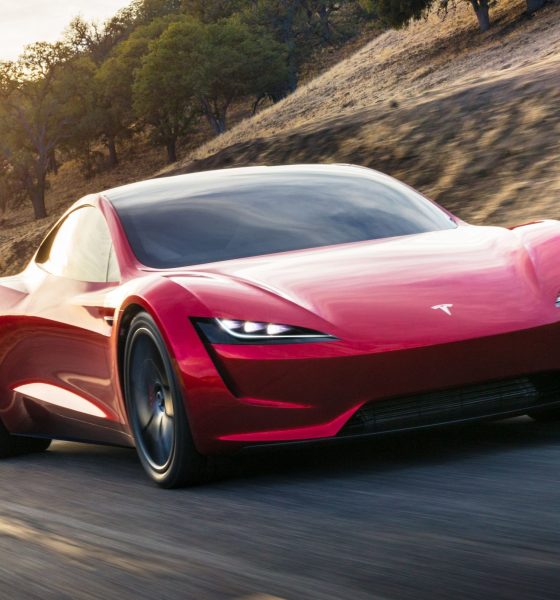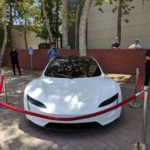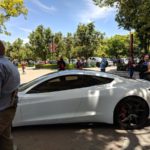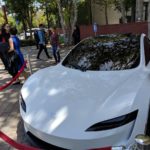

News
Tesla Roadster will have a “SpaceX option package” that boosts performance beyond base levels
Tesla CEO Elon Musk has revealed that the next-generation Roadster will have a “SpaceX option package” that will upgrade the all-electric supercar’s performance to even higher levels.
Speaking during Tesla’s 2018 Annual Shareholder Meeting, Musk addressed the room full of investors that range and performance of the Tesla Semi and Roadster prototypes that were unveiled last November will be even better in the final production version. “In particular, the Tesla Roadster. What we unveiled with the Roadster was the base model performance. It’s going to have a SpaceX options package. It’s crazy,” said Musk.
The announcement reinforces a previous statement made about the general specifications of the all-electric supercar. Following its debut, Musk tweeted that there would be a “special option package” that takes the vehicle to the “next level.” In a follow-up tweet, Musk candidly noted that with the special upgrade, the next-gen Roadster would be able to fly “short hops,” considering that applying rocket technology opens up new possibilities for the vehicle.
Not saying the next gen Roadster special upgrade package *will* definitely enable it to fly short hops, but maybe …
Certainly possible. Just a question of safety. Rocket tech applied to a car opens up revolutionary possibilities.
— Elon Musk (@elonmusk) November 19, 2017
The specs of the next-gen Roadster with the SpaceX option package could very well be beyond hypercar territory. The base trim of the vehicle, after all, is already equipped with impressive features, such as a top speed of more than 250 mph, a 0-60 mph time of 1.9 seconds, a quarter-mile time of 8.9 seconds, a 200 kWh battery pack that gives 620 miles of range, and 10,000 Nm of torque from the supercar’s 3 electric motors.
The supercar is also equipped with “Plaid Mode,” Elon Musk’s latest nod to sci-fi comedy film Spaceballs that features even faster acceleration than the Model S P100D and Model X P100D’s Ludicrous Mode. With the SpaceX option, the next-generation Tesla Roadster would practically be an electric rocket on wheels — a vehicle that can, in Elon Musk’s words, truly deliver a “hardcore smackdown” to gasoline cars.
The next-gen Roadster carries much of the practicality that Tesla’s vehicles such as the Model S, Model X, and Model 3 are known for. Despite being a supercar, for example, the next-gen Roadster can seat four passengers, thanks to its 2+2 seating arrangement. Vehicles that feature comparable performance, such as the Koenigsegg Agera R and the Bugatti Chiron, and every vehicle in the hypercar trinity like the Porsche 918 Spyder, the Ferrari LaFerrari, and the McLaren P1, are exclusively 2-seaters.
- A white next-gen Tesla Roadster makes an appearance during the 2018 annual shareholders meeting. [Credit: Dennis Pascual/Twitter]
- A white next-gen Tesla Roadster makes an appearance during the 2018 annual shareholders meeting. [Credit: Dennis Pascual/Twitter]
- A white next-gen Tesla Roadster makes an appearance during the 2018 annual shareholders meeting. [Credit: Dennis Pascual/Twitter]
A white Tesla Roadster prototype is displayed outside of the Computer History Museum in Mountain View, CA on Tuesday, June 5, 2018 [Credit: Dennis Pascual via Twitter]
More importantly, the $200,000-$250,000 next-generation Roadster is also far more affordable than its gasoline-based competitors. The hypercar trinity, for one, are all in the $1 million price range. The Koenigsegg Agera R and the Bugatti Chiron, on the other hand, are even more expensive, with the former costing $2.1 million and the latter commanding a hefty $2.8 million price tag.
Tesla is starting to feature the next-generation Roadster more frequently on its social media channels and live events. During the company’s first-quarter all-hands promo video, the all-electric supercar’s blistering acceleration and its unique interior were highlighted prominently. Earlier this year, the vehicle was also displayed at Tesla’s Palo Alto headquarters.
Test drives of the next-gen Tesla Roadster are set to begin sometime towards the end of 2019. Production of the vehicle is expected to start in 2020.

News
Waymo sues Santa Monica over order to halt overnight charging sessions
In its complaint, Waymo argued that its self-driving cars’ operations do not constitute a public nuisance, and compliance with the city’s order would cause the company irreparable harm.

Waymo has filed a lawsuit against the City of Santa Monica in Los Angeles County Superior Court, seeking to block an order that requires the company to cease overnight charging at two facilities.
In its complaint, Waymo argued that its self-driving cars’ operations do not constitute a public nuisance, and compliance with the city’s order would cause the company irreparable harm.
Nuisance claims
As noted in a report from the Los Angeles Times, Waymo’s two charging sites at Euclid Street and Broadway have operated for about a year, supporting the company’s growing fleet with round-the-clock activity. Unfortunately, this has also resulted in residents in the area reportedly being unable to sleep due to incessant beeping from self-driving taxis that are moving in and out of the charging stations around the clock.
Frustrated residents have protested against the Waymos by blocking the vehicles’ paths, placing cones, and “stacking” cars to create backups. This has also resulted in multiple calls to the police.
Last month, the city issued an order to Waymo and its charging partner, Voltera, to cease overnight operations at the charging locations, stating that the self-driving vehicles’ activities at night were a public nuisance. A December 15 meeting yielded no agreement on mitigations like software rerouting. Waymo proposed changes, but the city reportedly insisted that nothing would satisfy the irate residents.
“We are disappointed that the City has chosen an adversarial path over a collaborative one. The City’s position has been to insist that no actions taken or proposed by Waymo would satisfy the complaining neighbors and therefore must be deemed insufficient,” a Waymo spokesperson stated.
Waymo pushes back
In its legal complaint, Waymo stated that its “activities at the Broadway Facilities do not constitute a public nuisance.” The company also noted that it “faces imminent and irreparable harm to its operations, employees, and customers” from the city’s order. The suit also stated that the city was fully aware that the Voltera charging sites would be operating around the clock to support Waymo’s self-driving taxis.
The company highlighted over one million trips in Santa Monica since launch, with more than 50,000 rides starting or ending there in November alone. Waymo also criticized the city for adopting a contentious strategy against businesses.
“The City of Santa Monica’s recent actions are inconsistent with its stated goal of attracting investment. At a time when the City faces a serious fiscal crisis, officials are choosing to obstruct properly permitted investment rather than fostering a ‘ready for business’ environment,” Waymo stated.
News
Tesla FSD v14.2.2 is getting rave reviews from drivers
So far, early testers have reported buttery-smooth drives with confident performance, even at night or on twisty roads.

Tesla Full Self-Driving (Supervised) v14.2.2 is receiving positive reviews from owners, with several drivers praising the build’s lack of hesitation during lane changes and its smoother decision-making, among others.
The update, which started rolling out on Monday, also adds features like dynamic arrival pin adjustment. So far, early testers have reported buttery-smooth drives with confident performance, even at night or on twisty roads.
Owners highlight major improvements
Longtime Tesla owner and FSD user @BLKMDL3 shared a detailed 10-hour impression of FSD v14.2.2, noting that the system exhibited “zero lane change hesitation” and “extremely refined” lane choices. He praised Mad Max mode’s performance, stellar parking in locations including ticket dispensers, and impressive canyon runs even in dark conditions.
Fellow FSD user Dan Burkland reported an hour of FSD v14.2.2’s nighttime driving with “zero hesitations” and “buttery smooth” confidence reminiscent of Robotaxi rides in areas such as Austin, Texas. Veteran FSD user Whole Mars Catalog also demonstrated voice navigation via Grok, while Tesla owner Devin Olsen completed a nearly two-hour drive with FSD v14.2.2 in heavy traffic and rain with strong performance.
Closer to unsupervised
FSD has been receiving rave reviews, even from Tesla’s competitors. Xpeng CEO He Xiaopeng, for one, offered fresh praise for FSD v14.2 after visiting Silicon Valley. Following extended test drives of Tesla vehicles running the latest FSD software, He stated that the system has made major strides, reinforcing his view that Tesla’s approach to autonomy is indeed the proper path towards autonomy.
According to He, Tesla’s FSD has evolved from a smooth Level 2 advanced driver assistance system into what he described as a “near-Level 4” experience in terms of capabilities. While acknowledging that areas of improvement are still present, the Xpeng CEO stated that FSD’s current iteration significantly surpasses last year’s capabilities. He also reiterated his belief that Tesla’s strategy of using the same autonomous software and hardware architecture across private vehicles and robotaxis is the right long-term approach, as it would allow users to bypass intermediate autonomy stages and move closer to Level 4 functionality.
News
Elon Musk’s Grok AI to be used in U.S. War Department’s bespoke AI platform
The partnership aims to provide advanced capabilities to 3 million military and civilian personnel.

The U.S. Department of War announced Monday an agreement with Elon Musk’s xAI to embed the company’s frontier artificial intelligence systems, powered by the Grok family of models, into the department’s bespoke AI platform GenAI.mil.
The partnership aims to provide advanced capabilities to 3 million military and civilian personnel, with initial deployment targeted for early 2026 at Impact Level 5 (IL5) for secure handling of Controlled Unclassified Information.
xAI Integration
As noted by the War Department’s press release, GenAI.mil, its bespoke AI platform, will gain xAI for the Government’s suite of tools, which enable real-time global insights from the X platform for “decisive information advantage.” The rollout builds on xAI’s July launch of products for U.S. government customers, including federal, state, local, and national security use cases.
“Targeted for initial deployment in early 2026, this integration will allow all military and civilian personnel to use xAI’s capabilities at Impact Level 5 (IL5), enabling the secure handling of Controlled Unclassified Information (CUI) in daily workflows. Users will also gain access to real‑time global insights from the X platform, providing War Department personnel with a decisive information advantage,” the Department of War wrote in a press release.
Strategic advantages
The deal marks another step in the Department of War’s efforts to use cutting-edge AI in its operations. xAI, for its part, highlighted that its tools can support administrative tasks at the federal, state and local levels, as well as “critical mission use cases” at the front line of military operations.
“The War Department will continue scaling an AI ecosystem built for speed, security, and decision superiority. Newly IL5-certified capabilities will empower every aspect of the Department’s workforce, turning AI into a daily operational asset. This announcement marks another milestone in America’s AI revolution, and the War Department is driving that momentum forward,” the War Department noted.











